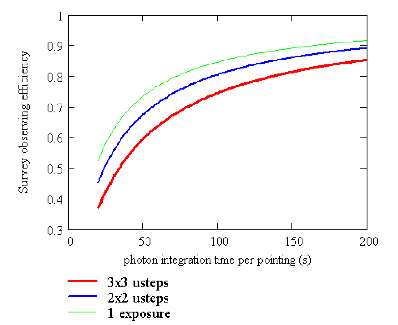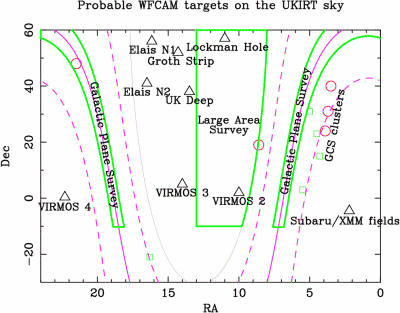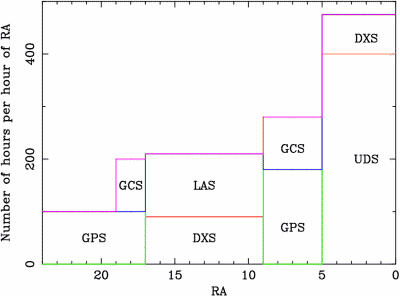
Figure 1.3. Estimated efficiency curves for WFCAM observing, i.e. the integration time over elapsed time in a single pointing as a function of integration time.
Here we look briefly at how observations will be carried out, their efficiency, and the time required to carry out each of the survey programme components.
Observing efficiency Eo. The camera needs to be moved in both microsteps (to sample the PSF) and in macrosteps (to produce a complete mosaic of the sky). The time spent staring at sky before any movement is tstare. (This might be broken into smaller individual exposures texp, for example to avoid saturating on the sky). The number of micro-steps is S = NXN (this is likely to be 2X2 or possibly 3X3). The interleaved data from a complete set of micro-stepped stares is known as a pointing, resulting in four separated images of the sky with a total integration time tint = S X tstare. Multiple pointings at a variety of positions can then be mosaiced and stacked to produce the final map of the sky. In the process a particular position on the sky may be visited say M times, so that the accumulated exposure on that sky position is tpos=MX tint.
However the actual time taken to produce a pointing is larger than tint because of overheads in initial acquisition, telescope movements, and readout. If the efficiency of observing is Eo, then the actual time taken over a pointing is tpoint=tint/Eo. Likewise after multiple visits and an accumulated exposure tpos, the total time spent visiting that sky position is tsky=tpos/Eo. The WFCAM Project Scientist has estimated Eo as a function of integration time and microstepping mode. This is shown in Fig. 1.3. Clearly very short integration times are not sensible. On the assumption of 2X2 microstepping, we choose tint=40, i.e. tstare=10 seconds, as the minimum integration time, with Eo~0.65. For deeper surveys one can achieve higher efficiency by staring longer before microstepping, but not so long that there is danger of significant seeing changes between micro-step positions. This needs more investigation, but for now we take a safe limit to be tstare=40 seconds, tint=160 seconds, leading to Eo~0.85.

Figure 1.3. Estimated efficiency curves for WFCAM
observing, i.e. the integration time over elapsed time in a single
pointing as a function of integration time.
Mosaic efficiency Em. Mosaics of pointings can be made in a number of ways, but there is always some inefficiency because of frame overlaps. The area of sky covered in the four disjoint frames is 0.21 sq. degs. If the area of sky to be covered is A then the number of pointings required is A/(0.21 X Em) where Em is the mosaic efficiency. The simplest mosaic is filling in the gaps in a 2X2 macrostep pattern to make a filled tile. Because the detectors are spaced at 90% of a detector width, one gets three 5% overlap strips in each direction so that the tile is 3.85 rather than 4 detector widths across, and Em=0.93. For a large area but shallow survey, each tile should be overlapped by a similar amount, so that it is 3.8 detector widths across and Em=0.90. For deep surveys, we can space the many pointings that are to be stacked on a fine grid to achieve a uniform exposure map, apart from a ramp-down at the edges. For a large area stacked survey, the edge effects will be negligible so that Em~1. For a small area deep stacked survey, the optimum gridding pattern is not clear because of the tradeoff between exposure uniformity and edge effects. We will investigate this further, but for the moment model our ultra-deep survey as a simple 4X4 tile, with mosaic efficiency Em=0.93.

Figure 1.4. The sky
distribution of UKIDSS targets, showing the preliminary choice of
fields, as well as alternative targets.¹ The GPS and LAS areas
fall within the thick solid lines. The GCS clusters are marked with
circles and small squares. The possible DXS and UDS survey areas (as
well as single deep X-ray fields) are marked with triangles. The
current choice for the UDS is the Subaru/XMM field. This is also one
of the chosen DXS fields, together with Elais N1, and the Lockman
hole. Other possibilities for the DXS include UK Deep, a field with
good X-ray and SIRTF coverage, and VIRMOS 2 and 4 which are currently
listed as targets in the CFH Legacy Survey.
¹ The latest field choices are kept up to date on the
surveys page
Useable time. We assume a fraction of useable time Fu=0.7. This is meant to encapsulate losses due to cloud, telescope down time, instrument problems etc. Assuming that we achieve a good RA balance (see below), we will observe at all times of year, and so assume an average number of 10 hours per night. The transmission does not need to be perfect. The deep stacked surveys (DXS and UDS) will be effectively self-calibrating and so able to use non-photometric but still reasonably clear time. The shallow surveys (GPS, LAS, and GCS) would ideally be made in photometric conditions, but could conceivably be made in poorer conditions and calibrated later with repeat UKIDSS observations (for variability and proper motion) or from 2MASS photometry. For image quality we will simply need to take almost all seeing conditions, as we propose to take such a large fraction of UKIRT time. We will probably want to use the best seeing to progress the deepest surveys, but this needs further modelling and scientific debate.
Calibration. We believe that the UKIDSS will be largely self-calibrating. Deep fields with many repeat visits only need one photometric visit and self-calibrate thereafter. Shallow surveys with only a single visit will require a set of calibration fields spread around RA, but these can largely be component fields of the various deeper surveys. Finally we will be able to calibrate from 2MASS stars, of which there will be a few per frame. These will often saturate in the stare time, but we intend to routinely perform 1sec non-destructive readouts for calibration purposes.
Sky distribution. Plotting the distribution of the target areas (Figure 1.4) demonstrates there are potential targets at all RAs with most at peak zenith distances <30o. The most direct way to assess demand for observing time spread over the whole survey is to plot the requested time in hours against RA. Figure 1.5 shows the result. This is reasonably uniform over RA, except for a mismatch between the RA ranges 0-5 and 19-24 hours. Optimising the RA distribution will be an important consideration in our final field choice. Adjustment of the final observation list will also have to take into account weather and darkness statistics and limitations due to the scheduling of the instrument.

Figure 1.5. A histogram plot of the total number of hours
integration (net) required with RA. The contributions from each
survey are marked. The LAS area covers a slightly wider range of RA
than in Figure 1.4. The UDS field is assumed to be the
Subaru Deep field, and for this plot we have assumed that the DXS
fields are XMM-Newton/LSS, the Lockman Hole and ELAIS N1. The
plot indicates a mismatch between the required time in the RA range
1-5 hours, and 19-24 hours that will need to be addressed when
finalising the fields to be observed.
Time required. Table 1.1 lists the characteristics of each component of the survey programme. The justification for the filters, depths and area of each component is given in the detailed science cases. The mosaic and observing efficiencies appropriate to each survey follow from the discussion above. The number of actual elapsed nights is estimated assuming an average of 10 hours per night, and 70% of night-time hours being useable. The total number of nights required is 946, or three years.
| Survey | Filter | Area | Mag. limit (Vega) |
tstare | tpos | Eo | Total | Nights |
|---|---|---|---|---|---|---|---|---|
| Large Area Survey LAS Em=0.9 |
Y | 4000 | 20.5 | 10s | 40s | 0.65 | 367h | 262 nts |
| J | 20.0 | 40x2s | 734h | |||||
| H | 18.8 | 40s | 367h | |||||
| K | 18.4 | 40s | 367h | |||||
| Galactic Plane Survey GPS Em=0.9 |
J | 1800 | 20.0 | 20s | 80s | 0.75 | 286h | 186 nts |
| H | 19.1 | 20s | 80s | 0.75 | 286h | |||
| K | 19.0 | 10s | 40x3s | 0.65 | 495h | |||
| H2 | 300 | ... | 37.5s | 150x3s | 0.85 | 237h | ||
| Galactic Clusters Survey GCS Em=0.9 |
J | 1600 | 19.7 | 10s | 40s | 0.65 | 147h | 84 nts |
| H | 18.8 | 40s | 147h | |||||
| K | 18.7 | 40x2s | 294h | |||||
| Deep Extragalactic Survey DXS Em=1.0 |
J | 35 | 22.5 | 40s | 2.1h | 0.85 | 415h | 118 nts |
| H | 5 | 22.0 | 4.4h | 124h | ||||
| K | 35 | 21.0 | 1.5h | 287h | ||||
| Ultra-Deep Survey UDS Em=0.93 |
J | 0.77 | 25.0 | 40s | 209h | 0.85 | 983h | 296 nts |
| H | 24.0 | 174h | 818h | |||||
| K | 23.0 | 58h | 271h | |||||
| TOTAL | 946 nts | |||||||
Table 1.1. Summary of requirements for each survey. Notes: (i) Mag limits are for point sources in median seeing. The assumed 5 sigma sensitivity in one hour is J=22.1, H=21.2, K=20.8. (ii) The necessary accumulated sky exposure in hours at one position is then tpos=10(0.8dm) where mag. difference dm = target mag - 1 hour sensitivity limit. (iii) The total on-sky exposure required is then tposX (A/0.207) X (1/Em) X (1/Eo) where A is the area in square degrees, and Em and Eo are the mosaic and observing efficiencies respectively. (iv) The number of nights required assumes an average of 10 hours per night, and a fraction of useable hours Fu=0.7.
How long will the programme take in elapsed years? We have calculated this as follows. The number of UKIDSS nights per year would be 365X FUKX FWFCAMX FUKIDSS. Here FUK=0.8 accounts for the 15% apportioned to the University of Hawaii, plus some Japanese time and Director's and engineering time. The Board has stated that WFCAM will be on the telescope for FWFCAM>0.6 of the total time. Of the WFCAM time a healthy fraction should be given over to PATT open competitive time, but we propose that the majority FUKIDSS=0.8 be used for the UKIDSS public survey. The future operational programme of UKIRT is still under debate, but the simplified operational mode required in the UK-ESO era requires WFCAM to be on the telescope a large fraction of the time. For FWFCAM=0.8, FUKIDSS=0.8, there would be 187 UKIDSS nights per year and the surveys would take 5.1 years. Alternatively for, say, FWFCAM=0.6, FUKIDSS=0.75, there would be 131 UKIDSS nights per year and the surveys would take 7.2 years.